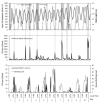Spatial and temporal variation in indicator microbe sampling is influential in beach management decisions
- PMID: 22365370
- PMCID: PMC3304019
- DOI: 10.1016/j.watres.2012.01.040
Spatial and temporal variation in indicator microbe sampling is influential in beach management decisions
Abstract
Fecal indicator microbes, such as enterococci, are often used to assess potential health risks caused by pathogens at recreational beaches. Microbe levels often vary based on collection time and sampling location. The primary goal of this study was to assess how spatial and temporal variations in sample collection, which are driven by environmental parameters, impact enterococci measurements and beach management decisions. A secondary goal was to assess whether enterococci levels can be predictive of the presence of Staphylococcus aureus, a skin pathogen. Over a ten-day period, hydrometeorologic data, hydrodynamic data, bather densities, enterococci levels, and S. aureus levels including methicillin-resistant S. aureus (MRSA) were measured in both water and sand. Samples were collected hourly for both water and sediment at knee-depth, and every 6 h for water at waist-depth, supratidal sand, intertidal sand, and waterline sand. Results showed that solar radiation, tides, and rainfall events were major environmental factors that impacted enterococci levels. S. aureus levels were associated with bathing load, but did not correlate with enterococci levels or any other measured parameters. The results imply that frequencies of advisories depend heavily upon sample collection policies due to spatial and temporal variation of enterococci levels in response to environmental parameters. Thus, sampling at different times of the day and at different depths can significantly impact beach management decisions. Additionally, the lack of correlation between S. aureus and enterococci suggests that use of fecal indicators may not accurately assess risk for some pathogens.
Copyright © 2012 Elsevier Ltd. All rights reserved.
Figures




Similar articles
-
Water quality, weather and environmental factors associated with fecal indicator organism density in beach sand at two recreational marine beaches.Sci Total Environ. 2014 Nov 1;497-498:440-447. doi: 10.1016/j.scitotenv.2014.07.113. Epub 2014 Aug 20. Sci Total Environ. 2014. PMID: 25150738 Free PMC article.
-
A multi-beach study of Staphylococcus aureus, MRSA, and enterococci in seawater and beach sand.Water Res. 2012 Sep 1;46(13):4195-207. doi: 10.1016/j.watres.2012.04.001. Epub 2012 Apr 21. Water Res. 2012. PMID: 22652414
-
Detection and modeling of Staphylococcus aureus and fecal bacteria in Hawaiian coastal waters and sands.Water Environ Res. 2024;96(5):e11037. doi: 10.1002/wer.11037. Water Environ Res. 2024. PMID: 38726833
-
Bacteria in beach sands: an emerging challenge in protecting coastal water quality and bather health.Environ Sci Technol. 2011 Jan 15;45(2):370-9. doi: 10.1021/es102747s. Epub 2010 Dec 16. Environ Sci Technol. 2011. PMID: 21162561 Free PMC article. Review.
-
Relationships between Microbial Indicators and Pathogens in Recreational Water Settings.Int J Environ Res Public Health. 2018 Dec 13;15(12):2842. doi: 10.3390/ijerph15122842. Int J Environ Res Public Health. 2018. PMID: 30551597 Free PMC article. Review.
Cited by
-
Staphylococcus aureus-An Additional Parameter of Bathing Water Quality for Crowded Urban Beaches.Int J Environ Res Public Health. 2021 May 14;18(10):5234. doi: 10.3390/ijerph18105234. Int J Environ Res Public Health. 2021. PMID: 34069077 Free PMC article.
-
Mechanisms for photoinactivation of Enterococcus faecalis in seawater.Appl Environ Microbiol. 2012 Nov;78(21):7776-85. doi: 10.1128/AEM.02375-12. Epub 2012 Aug 31. Appl Environ Microbiol. 2012. PMID: 22941072 Free PMC article.
-
Microbes in Beach Sands: Integrating Environment, Ecology and Public Health.Rev Environ Sci Biotechnol. 2014 Sep 1;13(3):329-368. doi: 10.1007/s11157-014-9340-8. Rev Environ Sci Biotechnol. 2014. PMID: 25383070 Free PMC article.
-
Human-associated methicillin-resistant Staphylococcus aureus from a subtropical recreational marine beach.Microb Ecol. 2013 May;65(4):1039-51. doi: 10.1007/s00248-013-0216-1. Epub 2013 Apr 4. Microb Ecol. 2013. PMID: 23553001
-
Quantitative microbial risk assessment of human illness from exposure to marine beach sand.Environ Sci Technol. 2012 Mar 6;46(5):2799-805. doi: 10.1021/es203638x. Epub 2012 Feb 22. Environ Sci Technol. 2012. PMID: 22296573 Free PMC article.
References
-
- Abdelzaher AM, Wright ME, Ortega C, Solo-Gabriele HM, Miller G, Elmir S, Newman X, Shih P, Bonilla JA, Bonilla TD, Palmer CJ, Scott T, Lukasik J, Harwood VJ, McQuaig S, Sinigalliano C, Gidley M, Plano LWR, Zhu X, Wang JD, Fleming LE. Presence of Pathogens and Indicator Microbes at a Non-Point Source Subtropical Recreational Marine Beach. Applied & Environmental Microbiology. 2010;76(3):724–732. doi:10.1128/AEM.02127-09. - PMC - PubMed
-
- Abdelzaher AM, Wright ME, Ortega C, Hasan AR, Shibata T, Solo-Gabriele HM, Kish J, Withum K, He G, Elmir SM, Bonilla JA, Bonilla TD, Palmer CJ, Scott TM, Lukasik J, Harwood VJ, McQuaig S, Sinigalliano CD, Gidley ML, Wanless D, Plano LRW, Garza AC, Zhu X, Stewart JR, Dickerson JW, Yampara-Iquise H, Carson C, Fleisher JM, Fleming LE. Daily measures of microbes and human health at a non-point source marine beach. Journal of Water Health. 2011;9(3):443–457. doi:10.2166/wh.2011.146. - PubMed
-
- Alm EW, Burke J, Hagan E. Persistence and potential growth of the fecal indicator bacteria, Escherichia coli, in shoreline sand at Lake Huron. Journal of Great Lakes Research. 2006;32(2):401–405. doi:10.3394/0380-1330.
-
- Boehm AB, Grant SB, Kim JH, Mowbray SL, McGee CD, Clark CD, Foley DM, Wellman DE. Decadal and shorter period variability of surf-zone water quality at Huntington beach, California. Environmental Science and Technology. 2002;36(18):3885–3892. doi:10.1021/es020524u. - PubMed
-
- Boehm AB, Weisberg SB. Tidal forcing of enterococci at marine recreational beaches at fortnighly and semidiurnal frequencies. Environmental Science and Technology. 2005;39(15):5575–5583. doi:10.1021/es048175m. - PubMed
Publication types
MeSH terms
Grants and funding
LinkOut - more resources
Full Text Sources

